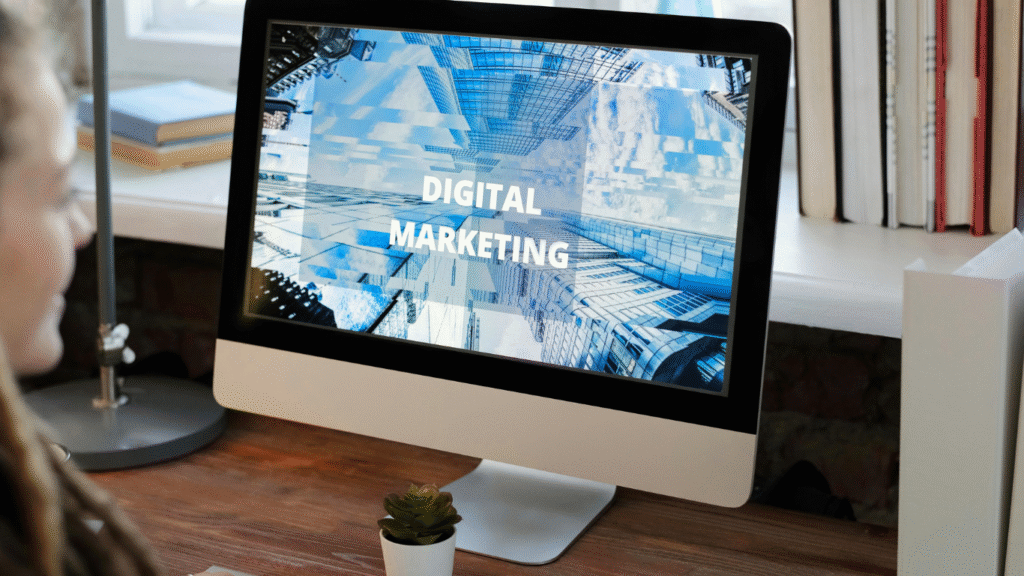What is Digital Marketing?

Introduction
In today’s fast-paced, digitally driven world, businesses of all sizes and industries are experiencing a fundamental shift in how they attract, engage, and retain customers. Gone are the days when placing an ad in a local newspaper or airing a radio commercial was enough to reach your target audience. Today, your customers live online they browse social media, search Google for answers, check reviews, read blogs, and shop on mobile devices.
This massive change in consumer behavior has given rise to a powerful and essential practice: digital marketing.
But what is digital marketing, exactly?
At its core, digital marketing is the use of online channels and technologies to promote products, services, and brands. It includes everything from websites and email campaigns to social media strategies, search engine optimization (SEO), paid advertising (PPC), and content creation. Unlike traditional marketing, digital marketing is interactive, data-driven, and measurable, allowing businesses to make smarter decisions and see real-time results.
For startups, digital marketing offers a cost-effective way to build brand awareness and generate leads. For large corporations, it’s a method to scale global reach, personalize user experiences, and drive conversions across complex customer journeys.
In this comprehensive guide, we’ll answer the question “What is digital marketing?” in depth. You’ll learn:
- How digital marketing differs from traditional marketing
- The main channels and strategies involved
- The key benefits of implementing a digital marketing strategy
- How it works in real-world business settings
- And how you can start leveraging it for your own success
Whether you’re a small business owner, a marketing student, or a curious entrepreneur, understanding the basics and the intricacies of digital marketing is crucial in today’s hyperconnected economy.
Let’s dive in and explore the dynamic world of digital marketing where data meets creativity, and strategy meets technology.
Why is Digital Marketing Important?
There are over 5 billion internet users worldwide, and that number is growing. People are spending more time on their devices than ever before researching, shopping, engaging, and being influenced.
Here’s why digital marketing matters:
- Reach: Engage a global audience at a fraction of the cost of traditional marketing.
- Targeting: Focus on specific demographics, behaviors, and interests.
- Analytics: Track campaign performance in real-time and adjust strategies instantly.
- Engagement: Interact with customers through comments, shares, reviews, and DMs.
Whether you’re running a local bakery or a multinational e-commerce brand, digital marketing allows you to level the playing field and compete effectively.
Core Channels of Digital Marketing

Let’s explore the primary types of digital marketing channels and how they work.
1. Search Engine Optimization (SEO)
SEO is the practice of optimizing your website to rank higher in search engine results pages (SERPs) for relevant keywordslike “what is digital marketing.”
Key elements of SEO include:
- On-page SEO: Optimizing titles, meta descriptions, headers, and content.
- Off-page SEO: Building backlinks from other reputable websites.
- Technical SEO: Improving site speed, mobile-friendliness, and crawlability.
2. Content Marketing
Content marketing focuses on creating valuable, relevant, and consistent content to attract and retain an audience.
Popular content types include:
- Blog posts (like this one)
- Ebooks and whitepapers
- Infographics
- Videos and webinars
Content helps establish authority, boost SEO, and nurture customer relationships.
3. Social Media Marketing
Platforms like Facebook, Instagram, LinkedIn, TikTok, and X (formerly Twitter) are essential for brand awareness and engagement.
Social media marketing includes:
- Organic posting
- Paid ads
- Influencer partnerships
- Community management
4. Email Marketing
Despite being one of the oldest digital channels, email marketing remains incredibly effective.
It’s ideal for:
- Customer retention
- Promotions and offers
- Nurture campaigns
- Event announcements
Key success factors: compelling subject lines, segmentation, personalization, and automation.
5. Pay-Per-Click Advertising (PPC)
PPC lets you place ads in search engines or social platforms and pay only when someone clicks.
Examples include:
- Google Ads (search & display)
- Facebook & Instagram Ads
- YouTube pre-roll ads
- LinkedIn sponsored posts
6. Affiliate Marketing
In affiliate marketing, you partner with individuals or websites that promote your product in exchange for a commission on sales.
It’s a performance-based model and often used by e-commerce brands and SaaS companies.
7. Influencer Marketing
Influencer marketing taps into the trust and reach of social media influencers. Brands partner with these individuals to promote products or services to their audience.
| Feature | Traditional Marketing | Digital Marketing |
|---|---|---|
| Media | TV, radio, print | Social media, search engines |
| Targeting | Broad | Highly specific |
| Interactivity | One-way | Two-way (engagement) |
| Cost | High | Flexible (can be low-cost) |
| Analytics | Difficult to measure | Real-time insights |
| Flexibility | Low | High (easy to adjust) |
How Digital Marketing Works

- Define Your Goals: Brand awareness? Leads? Sales? Customer loyalty?
- Identify Your Target Audience: Who are you talking to?
- Choose the Right Channels: SEO, social media, PPC, or a mix?
- Create Valuable Content: Informative, engaging, and optimized.
- Launch Campaigns: Promote content via selected platforms.
- Analyze and Optimize: Use data to improve performance continually.
Pro Tip: Use tools like Google Analytics, SEMrush, or HubSpot to monitor performance.
Benefits of Digital Marketing
Here are some compelling benefits that highlight why every business should invest in digital marketing:
- Cost-Effective: Start with small budgets and scale as needed.
- Measurable ROI: Know exactly how your money is performing.
- Improved Conversion Rates: Personalized marketing increases engagement.
- 24/7 Marketing: Your campaigns work while you sleep.
- Increased Engagement: Real-time interaction with customers boosts trust.
- Global Reach with Local Focus: Target international markets or specific neighborhoods.
Getting Started with Digital Marketing
Starting your journey in digital marketing might seem overwhelming at first—but it doesn’t have to be. The beauty of digital marketing lies in its flexibility: you can start small, test what works, and gradually scale your efforts. Whether you’re a solopreneur, small business owner, or part of a growing team, having a clear plan helps you stay focused and avoid unnecessary detours.
Here’s a detailed roadmap to help you take your first confident steps into the world of digital marketing.
Step 1: Build a Strong Online Presence
Before launching any campaign, you need a solid digital foundation. Your online presence acts as your brand’s virtual storefront it’s the first place people go to learn about who you are, what you offer, and whether they can trust you.
Key tasks to complete:
- Create a professional website: Your website should be fast, mobile-friendly, secure (HTTPS), and easy to navigate. It should clearly display your value proposition, contact information, and calls-to-action (CTAs).
- Set up business profiles on major platforms: Start with Facebook, Instagram, LinkedIn, and Google Business Profile (formerly Google My Business). Choose the platforms your target audience uses most.
- Establish consistent branding: Use a consistent logo, brand colors, tone of voice, and messaging across all digital touchpoints.
Step 2: Start Small with One or Two Channels
It’s tempting to try everything at once SEO, PPC, social media, email, video, and more. But spreading yourself too thin often leads to poor results. Instead, begin with one or two digital marketing channels that best align with your business goals and resources.
Recommended starting channels:
- Search Engine Optimization (SEO): Ideal for long-term visibility and organic traffic. Optimize your website with relevant keywords like “what is digital marketing” to attract people searching for related topics.
- Email Marketing: Great for nurturing relationships and encouraging repeat visits or purchases. It’s cost-effective and delivers high ROI.
- Social Media Marketing: If your audience spends a lot of time on platforms like Instagram or Facebook, use organic posts or ads to drive engagement and traffic.
Tips for getting started:
- Define your goal (e.g., leads, traffic, brand awareness).
- Set a monthly budget even if it’s small.
- Learn basic platform best practices before launching.
Pro Tip: Choose one platform to master, measure results, then expand based on performance and capacity.
Step 3: Leverage Free Tools and Resources
You don’t need a massive budget to start with digital marketing. Many powerful free tools can help you build, manage, and analyze your marketing efforts efficiently.
Must-have free tools:
- Google Analytics: Tracks website traffic, user behavior, and conversion paths.
- Google Search Console: Monitors your site’s search performance, keyword rankings, and technical issues.
- Mailchimp (free plan): For creating and automating email campaigns.
- Canva: A user-friendly design tool for social media graphics, presentations, ads, and more.
- AnswerThePublic or Ubersuggest: For keyword research and content ideas.
- Hootsuite or Buffer (free versions): Schedule and manage social media posts.
By incorporating these tools early on, you’ll gain a better understanding of how digital marketing works, and you’ll be able to optimize your campaigns based on real data.
Step 4: Learn Continuously and Stay Updated
One of the defining characteristics of digital marketing is that it’s constantly evolving. Algorithms change, new platforms emerge, and consumer behaviors shift. Staying updated with industry trends is essential if you want your strategies to remain effective.
Ways to stay educated:
- Subscribe to leading marketing blogs: Try Neil Patel, HubSpot, Moz, Search Engine Journal, and Content Marketing Institute.
- Take free/affordable online courses: Platforms like Coursera, Udemy, Google Digital Garage, and HubSpot Academy offer beginner-to-advanced certifications.
- Listen to podcasts and watch YouTube tutorials: Quick ways to learn while on the go.
- Join online communities: Facebook Groups, Reddit threads like r/marketing, and LinkedIn groups can provide valuable peer-to-peer advice.
Mindset tip: Treat digital marketing like a craft. The more you practice and learn, the more confident and effective you’ll become.
Step 5: Consider Professional Help When You’re Ready to Scale
While DIY digital marketing is absolutely doable in the early stages, there comes a point when getting expert help makes financial and strategic sense. If your business is growing and your time is limited, hiring professionals can bring faster results and allow you to focus on what you do best.
Options for expert support:
- Freelancers: Affordable and flexible for one-off projects like blog writing, social media management, or PPC campaigns.
- Marketing Agencies: Offer a full suite of services, including SEO, web design, paid media, and analytics.
- In-house marketing team: Best for scaling companies with long-term marketing needs and internal resources.
Before hiring, make sure to:
- Set clear marketing goals.
- Ask for case studies or client references.
- Understand the scope of services and pricing models.
Conclusion
So, what is digital marketing? In short, it’s the art and science of connecting with your audience online. It’s measurable, scalable, and essential in the modern business landscape.
Whether you’re a freelancer, small business owner, or enterprise marketer, understanding the basics of digital marketing can unlock new growth opportunities and help you stay ahead of the competition.
Start with a strategy, pick your channels, create great content, and stay consistent and you’ll be well on your way to digital success. see
